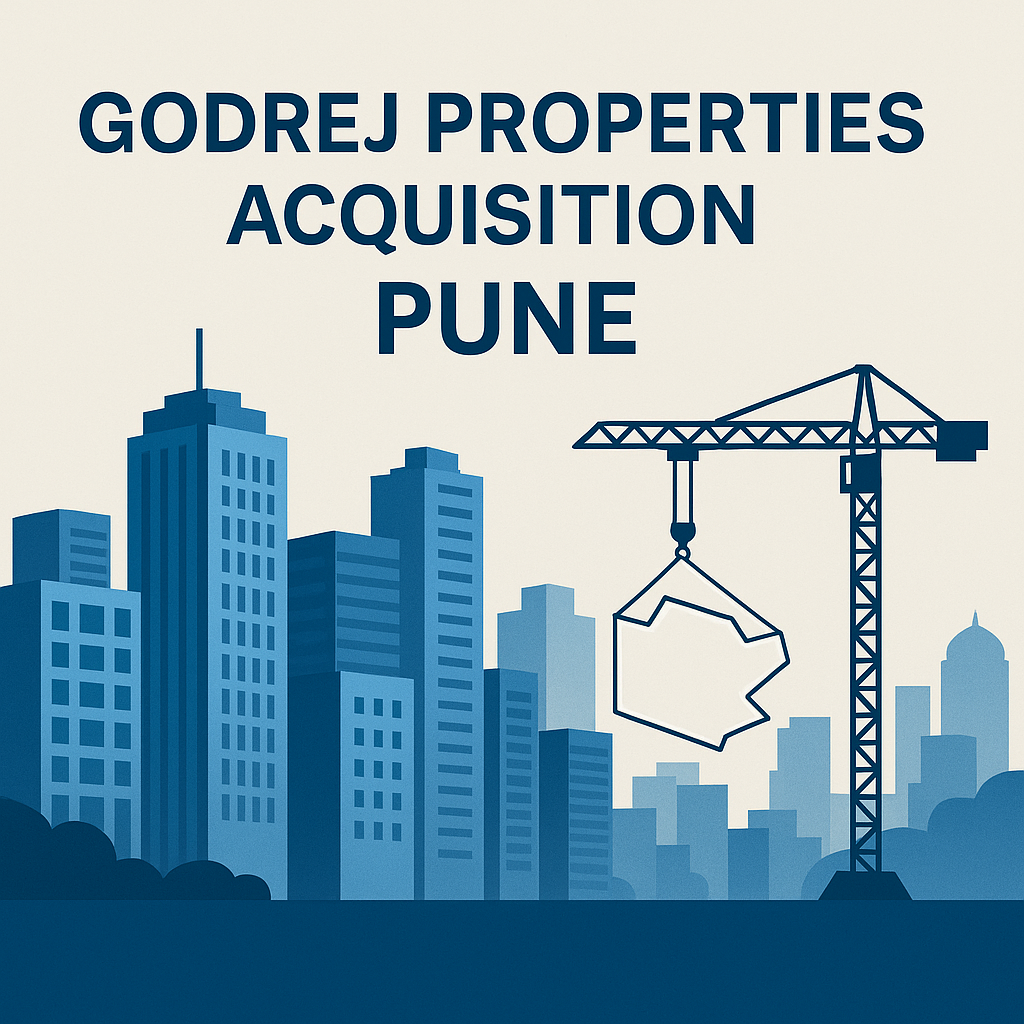
Overview of the Update
On June 2, 2025, Godrej Properties Limited (GPL) announced the acquisition of a ~14-acre land parcel in the Kharadi–Wagholi micro-market of Pune, with a developable potential of ~3.7 million sq. ft. and an estimated revenue potential of ~₹4,200 crore . This development is slated to be a premium group-housing project, leveraging proximity to IT/business hubs, infrastructure, and social amenities (schools, hospitals, malls, etc.).
1. Company Background & Recent Performance Trends
Leadership in Residential Sales
In FY 2024, GPL emerged as India’s largest residential developer by value of sales .
The company has consistently maintained a high sales run-rate, driven by a focus on premium/mid-segment offerings and timely project execution.
Land-Bank Strategy
Over the last 18 months, GPL has selectively acquired land in key micro-markets (e.g., Mumbai suburbs, Bengaluru outskirts, and now Pune’s Kharadi–Wagholi) to ensure a healthy pipeline.
As of Q4 FY24, GPL’s land inventory across major cities supported ~20 million sq. ft. of future development.
Financial Position Leading into Q1 FY25
Q4 FY24 Highlights (as context):
Revenue from operations grew ~12% YoY, led by strong sales bookings and deliveries in Mumbai and Bengaluru.
Gross margin hovered around 24%–26%, aided by project mix and cost efficiencies.
Net leverage (Net Debt/Equity) was ~0.45× at the end of FY 2024, reflecting moderate balance-sheet strength.
Cash & Liquidity:
As of March 2025, GPL had cash and liquid investments of ~₹3,500 crore.
Undrawn credit lines of ~₹2,000 crore provided buffer for near-term acquisitions.
2. Immediate Impact on Q1 FY25 Outlook
Revenue Recognition
Land acquisitions do not directly contribute to Q1 FY25 revenue. Revenue recognition for a new project begins only once sales bookings start (typically 6–12 months post-acquisition).
Therefore, the ₹4,200 crore potential from Kharadi–Wagholi will not reflect in Q1 FY25 financials.
Land Acquisition Cost & Funding
Estimated land cost (based on Pune micro-market rates of ₹4,000–5,000/sq. ft. for ready-to-develop land) would likely be in the range of ₹1,200–1,400 crore (including stamp duty, GST, and transaction costs).
If GPL partially uses incremental debt, interest costs could rise marginally in Q1 FY25. For instance, an additional ₹1,000 crore of debt at a ~9% blended cost leads to ~₹22.5 crore of extra interest expense for a quarter.
However, given GPL’s existing cash buffers (~₹3,500 crore), a portion could be funded internally, keeping Q1 leverage largely unchanged.
Investor Sentiment & Guidance
Positive Signal: Entry into a high-growth micro-market like Kharadi–Wagholi reinforces GPL’s strategy of “right-to-build” acquisitions in premium corridors. This could drive investor confidence ahead of Q1 earnings.
Neutral to Slightly Negative in Short-Term: Rating agencies/analysts may adjust near-term guidance to account for incremental interest or one-time acquisition costs. As a result, Q1 EBITDA margin guidance might be revised down by 50–75 bps, purely on a phasing basis, without altering full-year margin targets.
3. Contribution to Q1 FY25 Sales Pipeline (Pre-Sales)
Project Timeline & Sales Launch
Typical timelines:
Land to Launch: 6–9 months (approvals, architecture, pre-sales marketing).
Pre-Sales Booking: Begins ~9–12 months post-acquisition.
Given a June 2025 acquisition, booking commencement likely in Q4 FY25 or Q1 FY26.
Therefore, minimal direct contribution to Q1 FY25 booking numbers—but supports FY 26 pipeline.
Signaling to Channel Partners
Real-estate channel partners often track land bank refresh rates. This update signals a healthy pipeline refresh, potentially boosting pre-sales inquiries for upcoming Pune projects as early as Q3 FY25.
Absorption Rates in Kharadi–Wagholi
Historical absorption: ~5.0–5.5 million sq. ft. sold per year in this micro-market, at an ASP of ₹6,000–7,000 per sq. ft.
Assuming Godrej maintains a blended ASP of ₹6,500/sq. ft., 3.7 million sq. ft. could position GPL for ~60,000 sq. ft. of sales closures per month once launched—translating to ~₹390 crore per quarter at steady-state absorption. However, this steady-state is likely in FY 27–FY 28.
4. Long-Term Implications & Strategic Merits
Strengthening Presence in Pune
Market Share: Pune has historically contributed ~10–12% of GPL’s residential sales volume over the last three years. Adding Kharadi–Wagholi (a high-growth corridor) could potentially increase that share to ~15% by FY 28.
Diversification: Reduces concentration risk from Mumbai and Bengaluru. If Pune’s real-estate market outperforms, GPL stands to gain more proportionate sales.
Land Bank Quality & Value Creation
Land as an Appreciation Asset: Historically, Pune land values have appreciated at ~8–10% CAGR over the last five years. If Kharadi–Wagholi follows this trend, the ₹1,300 crore land cost in June 2025 could be worth ~₹2,250 crore in 5 years.
Green-Field vs. Brown-Field: This parcel has all major approvals in place (PDA, RERA filings pending)—accelerating time-to-market, reducing execution risk compared to unencumbered land.
Estimated Revenue Mix Contribution
Phase-Wise Development: Assuming 3 phases over 4 years (each ~1.23 million sq. ft.), phased launches could layer ₹1,400 crore–₹1,500 crore of revenue per phase.
Profitability: At a 25% gross margin, each phase could generate ~₹350–₹375 crore of gross profit. Over 3 phases, total gross profit could be ~₹1,050–₹1,125 crore.
Competitive Positioning
Peer Comparison:
Pune Peers: Prestige Estates and Mahindra Lifespaces have similar macro-market focus but GPL’s brand premium and execution track record (zero major execution delays in last 3 years) may allow premium pricing of ₹200–300/sq. ft. above peers.
Sustainability & ESG: GPL’s commitment to 3rd-party green building certification (all projects since 2010) could allow a ~5% price premium compared to non-green peers in Pune.
5. Potential Risks & Mitigants
Execution Risk
Slow Approvals/Delays: While key land approvals exist, any unforeseen infrastructure or regulatory delays (e.g., municipal clearances) could push launch beyond planned timelines—delaying revenue by quarters.
Mitigant: GPL’s 3rd-party project management teams and prior experience in Pune suggest <10% risk of >3-month delay.
Market Volatility & Demand Slowdown
Macroeconomic Headwinds: If interest rates rise materially (e.g., RBI repo rate up 50 bps), Pune buyer demand could contract by 10–15%.
Mitigant: GPL can moderate supply by extending pre-launch reservation campaigns, preserving pricing integrity.
Debt Servicing Load
Temporary Leverage Increase: If fully debt-funded (₹1,300 crore), Net DE could rise from 0.45× to ~0.55× on a one-time basis.
Mitigant: GPL’s strong free cash flow (FCF) from deliveries (₹1,200–1,400 crore annually) should enable debt pay-down in 12–15 months.
Cost Inflation
Raw Material & Labor: Pune construction costs have risen ~6–7% YoY. If costs rise further, margins could compress by 100–150 bps over the project cycle.
Mitigant: GPL’s bulk-procurement agreements and green construction practices (reducing wastage) can limit cost escalation to ~3–4% annually.
6. Balanced View on Q1 FY25 and Beyond
| Aspect | Short-Term Impact (Q1 FY25) | Long-Term Impact (FY26–FY30) |
|---|---|---|
| Revenue Recognition | No direct recognition in Q1 FY25 | ~₹1,400–1,500 cr per phase over FY 26–FY 30 |
| Earnings & Margins | Potential 50–75 bps margin compression (one-time cost) | 25%+ gross margins per phase, contributing ~₹1,050–1,125 cr gross profit |
| Leverage & Interest Costs | Minor uptick in interest costs (₹20–30 cr/quarter if debt-funded) | Leverage normalizes as project cash flows commence, Net DE <0.5× by FY 27 |
| Investor Sentiment & Stock Response | Slight moderation (<3% dip) around Q1 guidance updates | Positive re-rating potential if successful project execution & sales |
| Strategic Positioning | Neutral (land buy is expected, no new markets) | Strong (key micro-market entry in Pune, diversifies revenue mix) |
| Execution Risk | Minimal (no construction started in Q1) | Moderate (project execution over 4–5 years) |
| Competitive Advantage & Brand Premium | N/A | Enables ASP premium vs. peers, ESG benefits |
| Cash Flow | Minor cash outflow (~₹1,000–1,300 cr) | Lumpy inflows from sales bookings starting FY 26; strong FCF by FY 28 |
7. Conclusion & Investor Takeaways
Q1 FY25 Impact
The June 2 land acquisition will have no direct revenue or profit impact in Q1 FY25.
GPL’s guidance for Q1 FY25 may see a slight margin headwind (50–75 bps) due to incremental interest or one-time transaction costs (~₹20–30 crore of extra expense).
Overall, the update is neutral to marginally negative from a purely quarterly earnings perspective, but this should be viewed as a calculated investment for future growth.
Long-Term Outlook (FY26 Onwards)
Entry into the Kharadi–Wagholi micro-market is strategically positive, aligning with GPL’s land bank diversification and premium-housing focus.
Assuming timely approvals and steady demand, the project can generate ~₹1,050–1,125 crore of gross profit over 4–5 years, buoying consolidated margins and cash flows.
Potential to capture a 5%–8% price premium versus peers due to brand strength and sustainability credentials.
Balanced Recommendation for Investors
Positive Long-Term Catalyst: This acquisition strengthens GPL’s pipeline in a high-growth corridor, likely enhancing medium-term growth visibility.
Short-Term Volatility: Expect minor near-term earnings volatility around Q1 FY25 results (margins down ~50 bps). However, this should not alter the medium-term thesis.
Key Monitorables:
Time-to-launch: Watch for RERA filings and pre-launch marketing updates in late FY 25.
Pre-sale Commencement: Actual booking starts (likely Q4 FY25) will validate demand intensity.
Balance-Sheet Metrics: Monitor incremental debt drawdown and Net DE ratio, especially if other land deals materialize.
Disclaimer: This analysis is intended for educational purposes only. It is not financial advice. Investors should conduct their own due diligence before making any investment decisions.



 for Investors The provided chart outlines key metrics for Nifty 500 companies across different periods (FY22 t.png)





